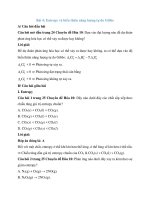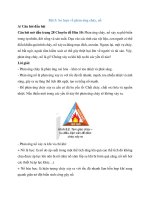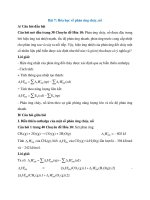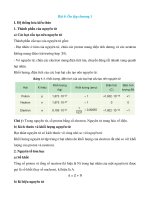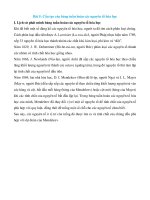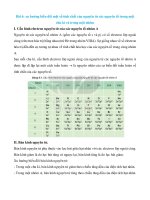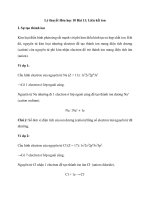TRẮC NGHIỆM KẾ TOÁN QUẢN TRỊ 1
Bạn đang xem bản rút gọn của tài liệu. Xem và tải ngay bản đầy đủ của tài liệu tại đây (2.9 MB, 78 trang )
CHAPTER 2
1. The costs of direct materials are classified as:
Conversion cost
Manufacturing cost
Prime cost
(I)
Yes
Yes
Yes
(II)
No
No
No
(III)
Yes
Yes
No
(IV)
No
Yes
Yes
Choice (IV)
2. Differential costs can: be either fixed or variable.
3. Waldhauser Corporation's relevant range of activity is 3,000 units to 7,000 units.
When it produces and sells 5,000 units, its average costs per unit are as follows:
Average
Cost per Unit
Direct materials
$
6.10
Direct labor
$
3.45
Variable manufacturing overhead
$
1.75
Fixed manufacturing overhead
$
3.30
Fixed selling expense
$
0.75
Fixed administrative expense
$
0.60
Sales commissions
$
1.50
Variable administrative expense
$
0.45
If 6,000 units are sold, the total variable cost is closest to: $79,500
(6.1+3.45+1.75+1.5+0.45)*6,000 = 79,500
4. Rhome Corporation's relevant range of activity is 2,000 units to 6,000 units. When it
produces and sells 4,000 units, its average costs per unit are as follows:
Average
per Unit
Cost
Direct materials
$
5.40
Direct labor
$
3.55
Variable manufacturing overhead
$
1.70
Fixed manufacturing overhead
$
3.00
Fixed selling expense
$
0.60
Fixed administrative expense
$
0.40
Sales commissions
$
1.00
Variable administrative expense
$
0.40
If 5,000 units are sold, the variable cost per unit sold is closest to: $12.05
5.4+3.55+1.7+1+0.4=12.05
5. The cost of lubricants (dầu nhờn) used to grease a production machine in a
manufacturing company is an example of a(n): indirect material cost.
6. Mullennex Corporation's relevant range of activity is 2,000 units to 6,000 units. When
it produces and sells 4,000 units, its average costs per unit are as follows:
Average
Cost per Unit
Direct materials
$
6.55
Direct labor
$
3.50
Variable manufacturing overhead
$
1.25
Fixed manufacturing overhead
$
3.00
Fixed selling expense
$
0.50
Fixed administrative expense
$
0.40
Sales commissions
$
1.50
Variable administrative expense
$
0.40
If 5,000 units are produced, the average fixed manufacturing cost per unit produced is closest
to: $2.40
(3*4,000)/5,000 = 2.4
7. Meginnis Corporation's relevant range of activity is 3,000 units to 7,000 units. When
it produces and sells 5,000 units, its average costs per unit are as follows:
Average
Cost per Unit
Direct materials
$
5.20
Direct labor
$
3.75
Variable manufacturing overhead
$
1.65
Fixed manufacturing overhead
$
2.60
Fixed selling expense
$
0.50
Fixed administrative expense
$
0.40
Sales commissions
$
1.50
Variable administrative expense
$
0.50
If 6,000 units are produced, the total amount of direct manufacturing cost incurred is closest
to: $53,700
(5.2+3.75)*6,000= 53,700
8. The cost of direct materials is classified as a:
(I)
Conversion cost
Prime cost
No
No
(II)
Yes
No
(III)
No
Yes
(IV)
Yes
Yes
Choice (III)
9. Which of the following statements concerning direct and indirect costs is NOT true?
10. Schwiesow Corporation has provided the following information:
Cost
Unit
per
Cost per Period
Direct materials
$
7.05
Direct labor
$
3.50
Variable manufacturing overhead
$
1.65
Fixed manufacturing overhead
Sales commissions
$
1.00
Variable administrative expense
$
0.40
Fixed selling and administrative expense
$
11,000
$
5,500
For financial reporting purposes, the total amount of product costs incurred to make 5,000
units is closest to: $72,000
(7.05+3.5+1.65)*5,000 + 11,000 = 72,000
11. Product costs that have become expenses can be found in: COGS
12. Management of Plascencia Corporation is considering whether to purchase a new
model 370 machine costing $360,000 or a new model 220 machine costing $340,000
to replace a machine that was purchased 7 years ago for $348,000. The old
machine was used to make product I43L until it broke down last week. Unfortunately,
the old machine cannot be repaired.
Management has decided to buy the new model 220 machine. It has less capacity than the
new model 370 machine, but its capacity is sufficient to continue making product I43L.
Management also considered, but rejected, the alternative of simply dropping product I43L.
If that were done, instead of investing $340,000 in the new machine, the money could be
invested in a project that would return a total of $411,000.
In making the decision to buy the model 220 machine rather than the model 370 machine:
- The sunk cost was: $348,000
- The opportunity cost was: $411,000
13. The following data pertains to activity and costs for two months:
June
Activity level in units
Direct materials
July
10,000
$
17,000
11,000
$
?
Fixed factory rent
21,000
?
Manufacturing overhead
20,000
?
Total cost
$
58,000
$
61,300
Assuming that these activity levels are within the relevant range, the manufacturing overhead
for July was: $21,600
In July, Direct materials cost = 17,000*11,000/10,000 = 18,700
Fixed factory rent = 21,000
=> Manufacturing overhead = 61,300 - 18,700 - 21,000 = 21,600
14. Boersma Sales, Inc., a merchandising company, reported sales of 7,100 units in
September at a selling price of $682 per unit. Cost of goods sold, which is a variable cost,
was $317 per unit. Variable selling expenses were $44 per unit and variable administrative
expenses were $22 per unit. The total fixed selling expenses were $157,200 and the total
administrative expenses were $338,000.
The contribution margin for September was: $2,122,900
7,100*(682-317-44-22)= 2,122,900
14. A cost incurred in the past that is not relevant to any current decision is classified as
a(n): sunk cost
15. The cost of electricity for running production equipment is classified as:
Conversion cost
Period cost
(I)
Yes
No
(II)
Yes
Yes
(III)
No
tYes
(IV)
No
No
Choice (I)
16. Materials used in a factory that are not an integral part of the final product, such as
cleaning supplies, should be classified as: manufacturing overhead.
17. Factory overhead is typically a(n): mixed cost.
18. All of the following can be differential costs except: sunk costs.
19. Comparative income statements for Boggs Sports Equipment Company for the last
two months are presented below:
July
Sales in units
Sales
August
11,000
$
165,000
10,00
0
$
150,0
00
Cost of goods sold
72,600
66,00
0
Gross margin
92,400
84,00
0
Selling and administrative expenses:
Rent
$
12,000
$
12,00
0
Sales commissions
$
13,200
$
12,00
0
Maintenance expenses
$
13,500
$
13,00
0
Clerical expense
$
16,000
$
15,00
0
Total selling and administrative expenses
$
54,700
$
52,00
0
Net operating income
$
37,700
$
32,00
0
All of the company's costs are either fixed, variable, or a mixture of the two (i.e., mixed).
Assume that the relevant range includes all of the activity levels mentioned in this problem.
Which of the selling and administrative expenses of the company is variable?
20. Mccaskell Corporation's relevant range of activity is 7,000 units to 11,000 units.
When it produces and sells 9,000 units, its average costs per unit are as follows:
Average
per Unit
Cost
Direct materials
$
6.30
Direct labor
$
3.65
Variable manufacturing overhead
$
1.75
Fixed manufacturing overhead
$
9.90
Fixed selling expense
$
2.25
Fixed administrative expense
$
1.80
Sales commissions (tiền hoa hồng)
$
1.00
0.50
Variable administrative expense
$
If 8,000 units are produced, the total amount of indirect manufacturing cost incurred is closest
to: $103,100
Fixed manufacturing overhead = 9.9*9000 = 89,100
Variable manufacturing overhead = 1.75*8000 = 14,000
Indirect manufacturing cost = 89,100 + 14,000 = 103,100
21. Kneeland Corporation has provided the following information:
Cost per Unit
Direct materials
$
6.80
Direct labor
$
4.15
Variable manufacturing overhead
$
1.65
Fixed manufacturing overhead
Sales commissions
$
1.00
Variable administrative expense
$
0.50
Fixed selling and administrative expense
Cost per Period
$
121,500
$
40,500
If 10,000 units are produced, the total amount of manufacturing overhead cost is closest to:
$138,000 = 1.65*10,000 + 121,500
22. Abburi Company's manufacturing overhead is 60% of its total conversion costs. If
direct labor is $52,000 and if direct materials are $28,000, the manufacturing
overhead is: $42,000
total conversion costs = direct materials cost + manufacturing overhead
=> manufacturing overhead*100/60 = 28,000 + manufacturing overhead
=> manufacturing overhead = 42,000
23. Which of the following is an example of a period cost in a company that makes
clothing?
24. Within the relevant range, variable costs can be expected to:
25. Lagle Corporation has provided the following information:
Cost per Unit
Direct materials
$
4.85
Direct labor
$
3.35
Variable manufacturing overhead
$
1.35
Fixed manufacturing overhead
Sales commissions
$
1.50
Variable administrative expense
$
0.45
Fixed selling and administrative expense
Cost per Period
$
8,000
$
4,400
For financial reporting purposes, the total amount of period costs incurred to sell 4,000 units
is closest to: $12,200
(1.5+0.45)*4,000 + 4,400 = 12,200
26. Rarotonga Manufacturing Company leases a vehicle to deliver its finished products to
customers. Which of the following terms correctly describes the monthly lease
payments made on the delivery vehicle?
Direct Cost
Fixed Cost
(I) Yes
Yes
(II) Yes
No
(III) No
Yes
(IV) No
No
Choice (III)
27. The relative proportion of variable, fixed, and mixed costs in a company is known as
the company's: cost structure.
28. Manufacturing overhead includes: all manufacturing costs except direct labor and
direct materials.
29. The following data have been collected for four different cost items.
Choice (II)
30. Which of the following would most likely NOT be included as manufacturing
overhead in a furniture factory?
31. Fasheh Corporation's relevant range of activity is 7,000 units to 11,000 units. When
it produces and sells 9,000 units, its average costs per unit are as follows:
$121,500 (fixed cost sẽ không thay đổi dù số lượng sản xuất có thay đổi ntn, nên vẫn lấy
units ban đầu nhân)
13.5*9,000 = 121.500
32. Wessner Corporation has provided the following information:
Cost per Unit
Direct materials
$
6.20
Direct labor
$
2.80
Variable manufacturing overhead
$
1.45
Fixed manufacturing overhead
Cost per Period
$
12,000
Sales commissions
$
1.00
Variable administrative expense
$
0.55
Fixed selling and administrative expense
$
4,000
If the selling price is $25.00 per unit, the contribution margin per unit sold is closest to:
$13.00
25-(6.2+2.8+1.45+1+0.55) = 13
33. Gabel Inc. is a merchandising company. Last month the company's merchandise
purchases totaled $63,000. The company's beginning merchandise inventory was
$13,000 and its ending merchandise inventory was $15,000. What was the company's
cost of goods sold for the month? $61,000
63,000 - (15,000 - 13,000) = 61,000
34. In the standard cost formula Y = a + bX, what does the "X" represent?
the level of activity
35. As the level of activity increases, how will a mixed cost in total and per unit behave?
Choice (I)
36. Perkey Corporation has provided the following information:
Cost per Unit
Direct materials
$
5.00
Direct labor
$
2.90
Cost per Period
Variable manufacturing overhead
$
1.25
Fixed manufacturing overhead
Sales commissions
$
1.00
Variable administrative expense
$
0.55
Fixed selling and administrative expense
$
21,000
$
7,500
If 4,000 units are produced, the total amount of direct manufacturing cost incurred is closest
to: $31,600
(5+2.9)*4,000 = 31,600
37. Which of the following statements about product costs is true?
CHAPTER 3
1. The following entry would be used to record depreciation on manufacturing
equipment: True
Manufacturing Overhead
XXX
Accumulated Depreciation
XXX
2. If a company uses a predetermined overhead rate, actual manufacturing overhead
costs of a period will be recorded in the Manufacturing Overhead account and will be
recorded on the job cost sheets: False
3. Entry (1) in the below T-account represents the purchase rather than use of raw
materials: True
Raw Materials
Bal.
10,000
(1)
70,000
Bal.
20,000
(2)
60,000
4. The $5,000 balance in the T-account below represents overapplied manufacturing
overhead for the period: False
Manufacturing Overhead
(2)
4,000
(3)
30,000
(4)
80,000
(5)
40,000
(6)
36,000
190,000
Bal.
(7)
180,000
180,000
10,000
5. Entry (4) in the below T-account could represent the cost of property taxes and
insurance incurred on the factory: True
Manufacturing Overhead
(2)
4,000
(3)
30,000
(4)
80,000
(5)
40,000
(6)
36,000
(7)
190,000
Bal.
180,000
180,000
10,000
6. The entire difference between the actual manufacturing overhead cost for a period and
the applied manufacturing overhead cost is typically closed to the Work In Process
account: False
7. The absorption cost approach provides for the absorption of all manufacturing costs,
fixed and variable, into units of product: True
8. When raw materials are purchased, they are recorded as an asset: True
9. Entry (4) in the T-account below represents raw materials requisitioned for use in
production: True
Raw Materials
Bal.
15,000
(3)
94,000
Bal.
22,000
(4)
87,000
1. On November 1, Arvelo Corporation had $32,000 of raw materials on hand. During
the month, the company purchased an additional $78,000 of raw materials. During
November, $95,000 of raw materials were requisitioned from the storeroom for use in
production. These raw materials included both direct and indirect materials. The
indirect materials totaled $3,000.Prepare journal entries to record these events. Use
those journal entries to answer the following questions:
The debits entered in the Raw Materials account during the month of November total:
2. Cienfuegos Corporation has provided the following data concerning last month's
operations.
Purchases of raw materials
$
36,000
Indirect materials included in manufacturing overhead
$
4,000
Direct labor cost
$
58,000
Manufacturing overhead applied to Work in Process
$
90,000
Overapplied overhead
$
3,000
Beginning
Ending
Raw materials inventory
$
10,000
$
21,000
Work in process inventory
$
62,000
$
70,000
Finished goods inventory
$
36,000
$
40,000
The company closes out any underapplied or overapplied manufacturing overhead to cost of
goods sold. How much is the adjusted cost of goods sold on the Schedule of Cost of Goods
Sold? $154,000
3. Rist Corporation uses a predetermined overhead rate based on machine-hours to apply
manufacturing overhead to jobs. The Corporation estimated that it would incur
$255,000 in manufacturing overhead during the year and that it would work 100,000
machine-hours. The Corporation actually worked 105,000 machine-hours and
incurred $270,000 in manufacturing overhead costs. By how much was manufacturing
overhead underapplied or overapplied for the year? $2,250 underapplied
4. Coatney Inc. has provided the following data for the month of October. There were no
beginning inventories; consequently, the direct materials, direct labor, and
manufacturing overhead applied listed below are all for the current month.
Manufacturing overhead for the month was overapplied by $7,000.
The Corporation allocates any underapplied or overapplied manufacturing overhead among
work in process, finished goods, and cost of goods sold at the end of the month on the basis
of the manufacturing overhead applied during the month in those accounts.
The finished goods inventory at the end of October after allocation of any underapplied or
overapplied manufacturing overhead for the month is closest to: 33,410
5. The journal entry to record applying overhead during the production process is:
6. At the beginning of the year, manufacturing overhead for the year was estimated to be
$670,700. At the end of the year, actual direct labor-hours for the year were 36,200
hours, the actual manufacturing overhead for the year was $665,700, and
manufacturing overhead for the year was overapplied by $22,100. If the
predetermined overhead rate is based on direct labor-hours, then the estimated direct
labor-hours at the beginning of the year used in the predetermined overhead rate must
have been: 35,300 direct labor-hours
7. In a job-order costing system, manufacturing overhead applied is recorded as a debit
to: Work in Process inventory.
8. Refer to the T-account below:
Entry (8) could represent which of the following?
Insurance cost incurred on the factory which is added to the Manufacturing Overhead
account.
9. Plasencia Corporation is a manufacturer that uses job-order costing. The company
closes out any overapplied or underapplied overhead to Cost of Goods Sold at the end
of the year. The company has supplied the following data for the just completed year:
Results of operations:
The net operating income is:
10. Solt Corporation uses a job-order costing system and has provided the following
partially completed T-account summary for the past year.
Finished Goods
Bal. 1/1
38,000
Debits
?
Bal. 12/31
50,000
Credits
?
The Cost of Goods Manufactured for the year was $415,000.The unadjusted Cost of Goods
Sold for the year was: 403,000
11.
Entry
(4)
could
represent
which
of
the
following
except?
12. Precision Corporation used a predetermined overhead rate last year of $3 per direct
labor-hour, based on an estimate of 24,000 direct labor-hours to be worked during the
year. Actual costs and activity during the year were:
Actual manufacturing overhead cost incurred
Actual direct labor-hours worked
The overapplied or underapplied manufacturing overhead for the year was:
$3,000 underapplied
$
84,000
27,000
13. Matthias Corporation has provided data concerning the Corporation's Manufacturing
Overhead account for the month of May. Prior to the closing of the overapplied or
underapplied balance to Cost of Goods Sold, the total of the debits to the
Manufacturing Overhead account was $53,000 and the total of the credits to the
account
was
$69,000.
Which
of
the
following
statements
is
true?
14. In a job-order costing system, indirect labor cost is usually recorded as a debit to:
15. Ruddick Corporation is a manufacturer that uses job-order costing. The company has
supplied the following data for the just completed year:
16. Dukes Corporation used a predetermined overhead rate this year of $2 per direct
labor-hour, based on an estimate of 20,000 direct labor-hours to be worked during the
year. Actual costs and activity during the year were:
Actual manufacturing overhead cost incurred
Actual direct labor-hours worked
The overapplied or underapplied manufacturing for the year was:
$
38,000
18,500
$1,000 underapplied
17. Fisher Corporation uses a predetermined overhead rate based on direct labor cost to
apply manufacturing overhead to jobs. The following information about Fisher
Corporation's Work in Process inventory account has been provided for the month of
May:
During the month, Fisher Corporation's Work in Process inventory account was credited for
$120,500, which represented the Cost of Goods Manufactured for the month. Only one job
remained in process on May 31; this job had been charged with $9,600 of applied overhead
cost. The amount of direct materials cost in the unfinished job would be: $10,600
18. Cai Corporation uses a job-order costing system and has provided the following
partially completed T-account summary for the past year.
The cost of indirect materials requisitioned for use in production during the year was:
19. During March, Pendergraph Corporation incurred $60,000 of actual Manufacturing
Overhead costs. During the same period, the Manufacturing Overhead applied to
Work in Process was $62,000.
The journal entry to record the incurrence of the actual Manufacturing Overhead costs would
include a:
20. Hougham Corporation uses a job-order costing system and has provided the following
partially completed T-account summary for the past year.
The cost of raw materials requisitioned for use in production during the year was:
21. Brendal Corporation is a manufacturer that uses job-order costing. The company has
supplied the following data for the just completed year:
Result of the operations:
How much is the total manufacturing cost added to Work in Process during the year?
$2,023,500
22. Frankin Corporation has provided the following data concerning last month's
operations.
How much is the cost of goods manufactured for the month on the Schedule of Cost of Goods
Manufactured?
23. Faughn Corporation has provided the following data concerning manufacturing
overhead for July:
The company's Cost of Goods Sold was $243,000 prior to closing out its Manufacturing
Overhead account. The company closes out its Manufacturing Overhead account to Cost of
Goods Sold. Which of the following statements is true?
Manufacturing overhead was overapplied by $10,000; Cost of Goods Sold after closing out
the Manufacturing Overhead account is $233,000
Actual manufacturing overhead incurred$69,000 Manufacturing overhead applied to Work in
Process 79,000 Underapplied (overapplied) manufacturing overhead$(10,000)
Adjusted cost of goods sold = Unadjusted cost of goods sold + Underapplied manufacturing
overhead - Overapplied manufacturing overhead = $243,000 + $0 - $10,000 = $233,000
24. On November 1, Arvelo Corporation had $32,000 of raw materials on hand. During
the month, the company purchased an additional $78,000 of raw materials. During
November, $95,000 of raw materials were requisitioned from the storeroom for use in
production. These raw materials included both direct and indirect materials. The
indirect materials totaled $3,000.Prepare journal entries to record these events. Use
those journal entries to answer the following questions:
The debits to the Work in Process account as a consequence of the raw materials
transactions in November total: $78,000
25. During June, Buttrey Corporation incurred $67,000 of direct labor costs and $7,000 of
indirect labor costs. The journal entry to record the accrual of these wages would
include a: debit to Work in Process of $67,000.
26. Under a job-order costing system, the dollar amount transferred from Work in Process
to Finished Goods is the sum of the costs charged to all jobs:
27. Tomlison Corporation is a manufacturer that uses job-order costing. The company has
supplied the following data for the just completed year:

